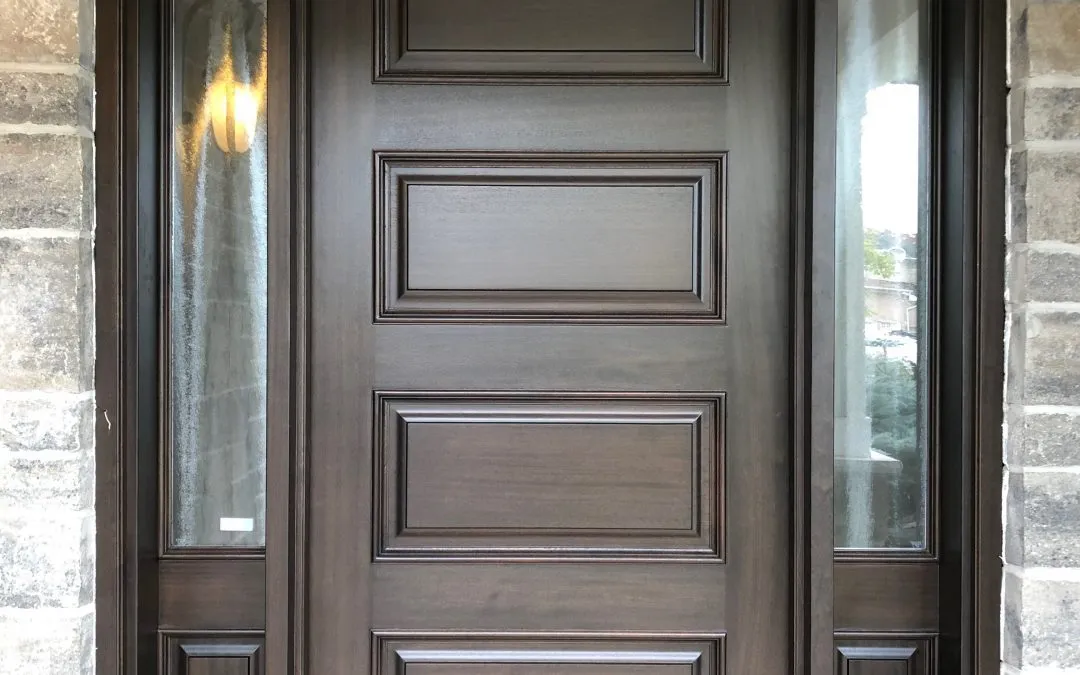When it comes to choosing doors, there is no doubt that we not only want a beautiful-looking door, but it should also be practical and of excellent quality. Since there are so many doors on the market, it’s not so easy.
Below we give you some tips on identifying a high-quality solid wood door.
1. Test the weight of the door
If the door is new and you haven’t hung it yet, either pick it up to guess its weight or weigh it on a scale. Solid doors are usually much heavier than a hollow core door and can weigh around 25 – 30 pounds heavier. So if you can easily lift or swing the door you most probably do not have a solid wood door.
2. Look at the finish on the door
The finish of a door is one of the clearest indicators of quality. High-quality solid wood doors are typically stained or sealed to showcase the natural grain, while lower-quality hollow-core doors are often painted to disguise artificial panels. A rich stain or clear finish highlights the wood’s natural look and protects it from moisture and wear.For homeowners, the finish has both aesthetic and functional purposes. A true hardwood door will display depth in grain and texture that paint cannot replicate. According to Fine Woodworking, finishes on real wood deepen with age and create a timeless look that hollow-core doors can’t match.
3. Examine the panelling on the door
The panelling style reveals much about door quality. Solid wood doors are usually built with frame-and-panel construction using hardwoods like oak, maple, or cherry. These panels are carved, detailed, and authentic. Hollow-core doors, on the other hand, often feature flat, artificial panels or pressed designs that lack depth.
Here’s a comparison of panelling between solid wood and hollow-core:
| Feature | Solid Wood Doors | Hollow-Core Doors |
| Construction | Frame-and-panel with natural wood | Pressed panels or molded surfaces |
| Appearance | Deep, detailed, and authentic wood grain | Shallow, artificial look |
| Durability | Resistant to wear; can be refinished multiple times | Easily damaged, limited refinishing |
| Materials | Hardwood or softwood panels (e.g., oak, maple) | Thin veneer or synthetic surface |
A strong, solid wood door will look better and hold its integrity for decades.
4. Check the door’s condition
The physical condition of the door is another clear sign of quality. High-quality doors made from solid wood resist dents, scratches, and long-term wear. Because of their density, solid wood doors show fewer signs of damage over time compared to hollow-core options, which can easily crack or chip due to their thin veneer and empty core.
Here’s how the condition compares:
| Aspect | Solid Wood Doors | Hollow-Core Doors |
| Durability | Very high; resistant to daily wear | Low; prone to dents and holes |
| Repairability | Can be sanded and refinished repeatedly | Limited; surface damage permanent |
| Longevity | 20–50+ years with care | 5–15 years depending on use |
| Value Retention | Holds value over time | Lower resale/upgrade value |
A well-maintained solid wood door can last a lifetime, making it a smart investment for both aesthetics and durability.
5. Consider the door’s price
It’s no secret that a solid wooden door is on the pricier side and that hollow-core doors are less expensive. Doors made of solid wood are made of quality natural wood. The wood is constructed as one whole unit, the sturdy wood adds weight, which makes the door easy to close, thick enough to block sound, and strong enough to hold custom framed mirrors.
Why Solid Wood Doors Are Considered High Quality
Solid wood doors have long been the gold standard for durability and beauty. Unlike hollow-core or engineered alternatives, they’re made entirely of natural wood, which gives them greater strength, weight, and soundproofing. Their density also provides superior insulation, which makes them a practical choice for energy efficiency.
Other than function, solid wood doors offer unmatched aesthetics. Each piece is unique, with natural variations in grain and colour that make every door one-of-a-kind.
How Solid Wood Doors Compare to Engineered Options
While engineered and hollow-core doors may be more affordable, they often lack the performance and value of solid wood doors. Here’s a breakdown:
| Feature | Solid Wood Doors | Engineered / Hollow-Core Doors |
| Durability | Extremely durable; can last 20–50+ years | Lower lifespan; prone to dents and cracks |
| Repairability | Can be sanded, refinished, and repaired | Limited; damage often permanent |
| Insulation | Excellent thermal and sound insulation | Minimal soundproofing, less energy-efficient |
| Appearance | Natural beauty; authentic grain patterns | Imitation finishes; lacks depth |
| Value | Long-term investment; retains property value | Short-term savings; lower resale impact |
As the table shows, solid wood doors deliver long-term value and quality that engineered options cannot match. This makes them a smarter investment for homeowners looking for high quality doors.
Signs of Craftsmanship in High-Quality Doors
When shopping for strong wood doors, details of craftsmanship are key indicators of quality. Here are signs to look for:
- Precise joinery: Well-made doors have tight joints with no gaps, showing expert woodworking.
- Consistent grain alignment: Panels are cut to match wood grain, creating a seamless appearance.
- Smooth finish application: Stains or varnishes should highlight, not hide, the natural grain.
- High-quality hardware placement: Hinges and handles are installed securely and align perfectly.
- Balanced weight: A good, solid wood door feels substantial but not overly heavy on its hinges.
Attention to these details ensures you’re investing in a door that reflects beauty and durability.
Common Myths About Solid Wood Doors
Many homeowners hesitate about solid wood doors because of common misconceptions. Here are the most frequent myths, debunked:
- “They warp easily.” High-quality hardwood doors are kiln-dried and sealed, making them very stable in most climates.
- “They’re too heavy for everyday use.” While heavier than hollow-core, solid wood doors are designed with proper hinges to operate smoothly.
- “Maintenance is constant.” With modern finishes and sealants, maintenance is minimal, usually just cleaning and resealing every few years.
- “Engineered doors look the same.” Hollow-core doors often lack depth of grain and can’t be refinished, unlike solid wood doors which age gracefully.
While these myths often deter buyers, in reality, hardwood doors are one of the most reliable and attractive choices for both interiors and exteriors.
Let us help you pick the perfect solid wood door
Master Doors has hundreds of standard options to choose from in a variety of wood species, sizes, and glass options. We have everything from wood front doors, solid wood exterior doors and custom entry doors. Browse through our website for the latest elegant styles of solid wood doors available for your picking.
FAQ's
How to identify a high-quality solid wood door
Yes. Hardwood doors (such as oak, maple, or mahogany) are generally stronger and more durable than softwood doors (like pine or cedar). Hardwoods have denser fibers, which make them more resistant to dents, scratches, and long-term wear. However, softwoods can still be a good choice for interiors or budget-friendly projects when properly finished and maintained.
Do solid wood doors last longer than engineered doors?
Absolutely. Solid wood doors can last several decades, often 30–50 years or more, with proper care. Engineered or hollow-core doors, by contrast, typically last 5–15 years before showing wear or structural issues. Solid wood doors can also be refinished multiple times, which extends their life beyond that of engineered doors.
Are solid wood doors worth the higher price?
Yes. While they require a higher initial investment, solid wood doors offer long-term benefits: exceptional durability, better insulation, timeless looks, and higher resale value for your home. Over time, the lower maintenance and longer lifespan make them a cost-effective choice compared to replacing engineered doors more frequently.
Do hardwood doors require more maintenance?
Not necessarily. Hardwood doors do require occasional sealing or refinishing to protect against moisture and UV rays, especially for exterior use. However, with modern protective finishes, maintenance is typically minimal, just seasonal cleaning and re-sealing every few years. For interior hardwood doors, maintenance is even less demanding.



